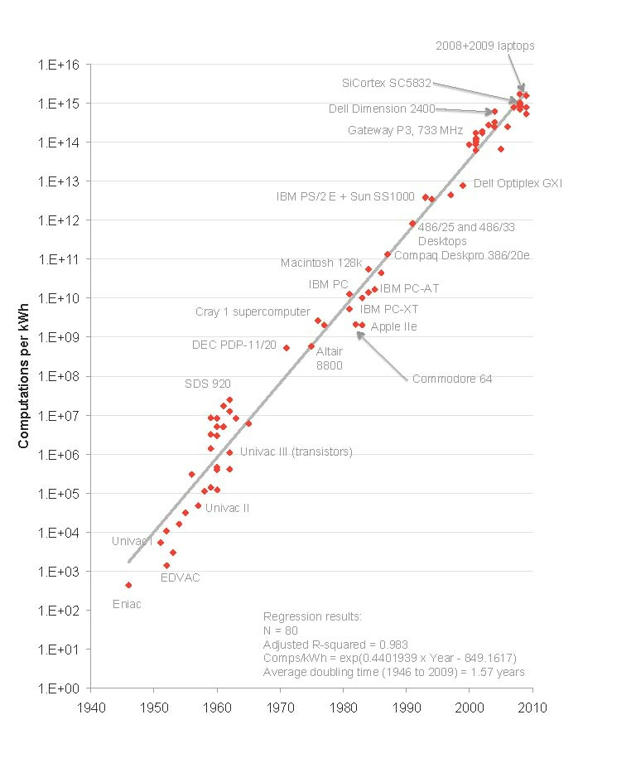More on efficiency trends in computing, from my forthcoming book
My book, Cold Cash, Cool Climate: Science-based Advice for Ecological Entrepreneurs, will be released on February 15, 2012. In Chapter 6, I discuss the power of mobile information and communication technology, and I reproduce that section below.
The Power of Mobile ICT
The performance of electronic computers has shown remarkable and steady growth over the past 60 years, a finding that is not surprising to anyone with even a passing familiarity with computing technology. What most folks don’t know, however, is that the electrical efficiency of computing (the number of computations that can be completed per kilowatt-hour of electricity) has doubled about every one and a half years since the dawn of the computer age (See Figure 6-1).[1] The existence of laptop computers, cellular phones, and personal digital assistants was enabled by these trends, which presage continuing rapid reductions in the power consumed by battery-powered computing devices, accompanied by new and varied applications for mobile computing, sensors, wireless communications and controls.
The most important future effect of these trends is that the power needed to perform a task requiring a fixed number of computations will fall by half every 1.5 years, enabling mobile devices performing such tasks to become smaller and less power consuming, and making many more mobile computing applications feasible. Alternatively, the performance of some mobile devices will continue to double every 1.5 years while maintaining the same battery life (assuming battery capacity doesn’t improve). These two scenarios define the range of possibilities. Some applications (like laptop computers) will likely tend towards the latter scenario, while others (like mobile sensors and controls) will take advantage of increased efficiency to become less power hungry and more ubiquitous.
These technologies will allow us to better match energy services demanded with energy services supplied, and vastly increase our ability to collect and use data in real time. They will also help us minimize the energy use and emissions from accomplishing human goals, a technical capability that we sorely need if we are to combat climate change in any serious way. The future environmental implications of these trends are profound and only just now beginning to be understood.[2]
As one of many examples of what is becoming possible using ultra low power computing, consider the wireless no-battery sensors created by Joshua R. Smith of Intel and the University of Washington.[3] These sensors scavenge energy from stray television and radio signals, and they use so little power (60 microwatts in this example) that they don’t need any other power source. Stray light, motion, or heat can also be converted to meet slightly higher power needs, perhaps measured in milliwatts.
The contours of this exciting design space are only beginning to be explored. Imagine wireless temperature, humidity, or pollution sensors that are powered by ambient energy flows, send information over wireless networks, and are so cheap and small that thousands can be installed where needed. Imagine sensors scattered throughout a factory so pollutant or materials leaks can be pinpointed rapidly and precisely. Imagine sensors spread over vast areas of glacial ice, measuring motion, temperature, and ambient solar insolation at very fine geographical resolution. Imagine tiny sensors inside products that tell consumers if temperatures while in transport and storage have been within a safe range. Imagine a solar powered outdoor trash can/compactor that notifies the dispatcher when it is full, thus saving truck trips (no need to imagine this one, it’s real[4]). In short, these trends in computing will help us lower greenhouse gas emissions and allow vastly more efficient use of resources.
Figure 6-1: Computations per kWh over time


Graph of computations/kWh from 1946 to 2009 by Jonathan Koomey is licensed under aCreative Commons Attribution-NonCommercial-NoDerivs 3.0 Unported License.
Permissions beyond the scope of this license may be available at http://www.koomey.com.
[1] Koomey, Jonathan G., Stephen Berard, Marla Sanchez, and Henry Wong. 2011. “Implications of Historical Trends in The Electrical Efficiency of Computing." IEEE Annals of the History of Computing. vol. 33, no. 3. July-September. pp. 46-54. [http://doi.ieeecomputersociety.org/10.1109/MAHC.2010.28]
[2] Greene, Kate. 2011. "A New and Improved Moore’s Law.” In Technology Review. September 12. [http://www.technologyreview.com/computing/38548/?p1=A1]
“A deeper law than Moore’s?” In The Economist. October 10, 2011. [http://www.economist.com/blogs/dailychart/2011/10/computing-power]
[3] Eisenberg, Anne. 2010. “Bye-Bye Batteries: Radio Waves as a Low-Power Source.” The New York Times. New York, NY. July 18. p. BU3. [http://www.nytimes.com/2010/07/18/business/18novel.html]
[4] [http://bigbellysolar.com/]
